Sidonie Lefebvre
Multispectral Texture Synthesis using RGB Convolutional Neural Networks
Oct 21, 2024Abstract:State-of-the-art RGB texture synthesis algorithms rely on style distances that are computed through statistics of deep features. These deep features are extracted by classification neural networks that have been trained on large datasets of RGB images. Extending such synthesis methods to multispectral images is not straightforward, since the pre-trained networks are designed for and have been trained on RGB images. In this work, we propose two solutions to extend these methods to multispectral imaging. Neither of them require additional training of the neural network from which the second order neural statistics are extracted. The first one consists in optimizing over batches of random triplets of spectral bands throughout training. The second one projects multispectral pixels onto a 3 dimensional space. We further explore the benefit of a color transfer operation upstream of the projection to avoid the potentially abnormal color distributions induced by the projection. Our experiments compare the performances of the various methods through different metrics. We demonstrate that they can be used to perform exemplar-based texture synthesis, achieve good visual quality and comes close to state-of-the art methods on RGB bands.
Self-Supervised Learning for Real-World Object Detection: a Survey
Oct 09, 2024



Abstract:Self-Supervised Learning (SSL) has emerged as a promising approach in computer vision, enabling networks to learn meaningful representations from large unlabeled datasets. SSL methods fall into two main categories: instance discrimination and Masked Image Modeling (MIM). While instance discrimination is fundamental to SSL, it was originally designed for classification and may be less effective for object detection, particularly for small objects. In this survey, we focus on SSL methods specifically tailored for real-world object detection, with an emphasis on detecting small objects in complex environments. Unlike previous surveys, we offer a detailed comparison of SSL strategies, including object-level instance discrimination and MIM methods, and assess their effectiveness for small object detection using both CNN and ViT-based architectures. Specifically, our benchmark is performed on the widely-used COCO dataset, as well as on a specialized real-world dataset focused on vehicle detection in infrared remote sensing imagery. We also assess the impact of pre-training on custom domain-specific datasets, highlighting how certain SSL strategies are better suited for handling uncurated data. Our findings highlight that instance discrimination methods perform well with CNN-based encoders, while MIM methods are better suited for ViT-based architectures and custom dataset pre-training. This survey provides a practical guide for selecting optimal SSL strategies, taking into account factors such as backbone architecture, object size, and custom pre-training requirements. Ultimately, we show that choosing an appropriate SSL pre-training strategy, along with a suitable encoder, significantly enhances performance in real-world object detection, particularly for small object detection in frugal settings.
Robust infrared small target detection using self-supervised and a contrario paradigms
Oct 09, 2024


Abstract:Detecting small targets in infrared images poses significant challenges in defense applications due to the presence of complex backgrounds and the small size of the targets. Traditional object detection methods often struggle to balance high detection rates with low false alarm rates, especially when dealing with small objects. In this paper, we introduce a novel approach that combines a contrario paradigm with Self-Supervised Learning (SSL) to improve Infrared Small Target Detection (IRSTD). On the one hand, the integration of an a contrario criterion into a YOLO detection head enhances feature map responses for small and unexpected objects while effectively controlling false alarms. On the other hand, we explore SSL techniques to overcome the challenges of limited annotated data, common in IRSTD tasks. Specifically, we benchmark several representative SSL strategies for their effectiveness in improving small object detection performance. Our findings show that instance discrimination methods outperform masked image modeling strategies when applied to YOLO-based small object detection. Moreover, the combination of the a contrario and SSL paradigms leads to significant performance improvements, narrowing the gap with state-of-the-art segmentation methods and even outperforming them in frugal settings. This two-pronged approach offers a robust solution for improving IRSTD performance, particularly under challenging conditions.
$\textit{A Contrario}$ Paradigm for YOLO-based Infrared Small Target Detection
Feb 03, 2024Abstract:Detecting small to tiny targets in infrared images is a challenging task in computer vision, especially when it comes to differentiating these targets from noisy or textured backgrounds. Traditional object detection methods such as YOLO struggle to detect tiny objects compared to segmentation neural networks, resulting in weaker performance when detecting small targets. To reduce the number of false alarms while maintaining a high detection rate, we introduce an $\textit{a contrario}$ decision criterion into the training of a YOLO detector. The latter takes advantage of the $\textit{unexpectedness}$ of small targets to discriminate them from complex backgrounds. Adding this statistical criterion to a YOLOv7-tiny bridges the performance gap between state-of-the-art segmentation methods for infrared small target detection and object detection networks. It also significantly increases the robustness of YOLO towards few-shot settings.
Deep-NFA: a Deep $\textit{a contrario}$ Framework for Small Object Detection
Mar 02, 2023Abstract:The detection of small objects is a challenging task in computer vision. Conventional object detection methods have difficulty in finding the balance between high detection and low false alarm rates. In the literature, some methods have addressed this issue by enhancing the feature map responses, but without guaranteeing robustness with respect to the number of false alarms induced by background elements. To tackle this problem, we introduce an $\textit{a contrario}$ decision criterion into the learning process to take into account the unexpectedness of small objects. This statistic criterion enhances the feature map responses while controlling the number of false alarms (NFA) and can be integrated into any semantic segmentation neural network. Our add-on NFA module not only allows us to obtain competitive results for small target and crack detection tasks respectively, but also leads to more robust and interpretable results.
A statistically constrained internal method for single image super-resolution
Feb 03, 2023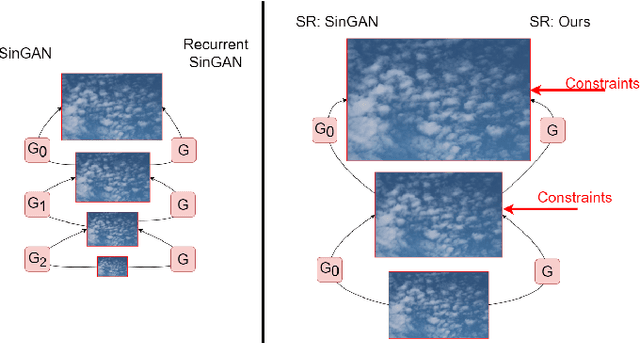
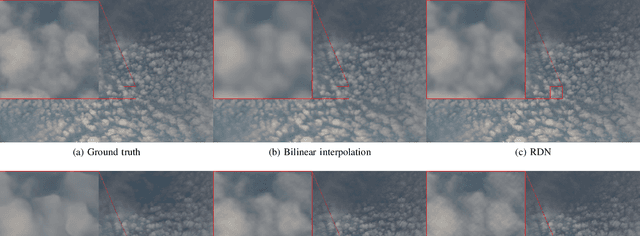

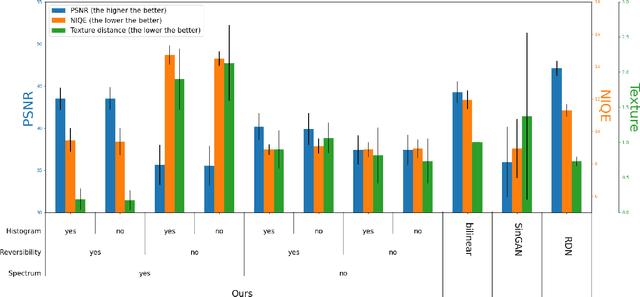
Abstract:Deep learning based methods for single-image super-resolution (SR) have drawn a lot of attention lately. In particular, various papers have shown that the learning stage can be performed on a single image, resulting in the so-called internal approaches. The SinGAN method is one of these contributions, where the distribution of image patches is learnt on the image at hand and propagated at finer scales. Now, there are situations where some statistical a priori can be assumed for the final image. In particular, many natural phenomena yield images having power law Fourier spectrum, such as clouds and other texture images. In this work, we show how such a priori information can be integrated into an internal super-resolution approach, by constraining the learned up-sampling procedure of SinGAN. We consider various types of constraints, related to the Fourier power spectrum, the color histograms and the consistency of the upsampling scheme. We demonstrate on various experiments that these constraints are indeed satisfied, but also that some perceptual quality measures can be improved by the proposed approach.
A geometrically aware auto-encoder for multi-texture synthesis
Feb 03, 2023Abstract:We propose an auto-encoder architecture for multi-texture synthesis. The approach relies on both a compact encoder accounting for second order neural statistics and a generator incorporating adaptive periodic content. Images are embedded in a compact and geometrically consistent latent space, where the texture representation and its spatial organisation are disentangled. Texture synthesis and interpolation tasks can be performed directly from these latent codes. Our experiments demonstrate that our model outperforms state-of-the-art feed-forward methods in terms of visual quality and various texture related metrics.
Détection de petites cibles par apprentissage profond et critère a contrario
Oct 03, 2022
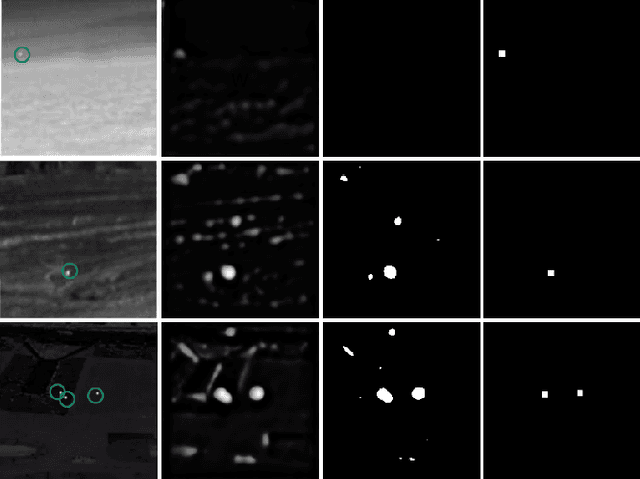
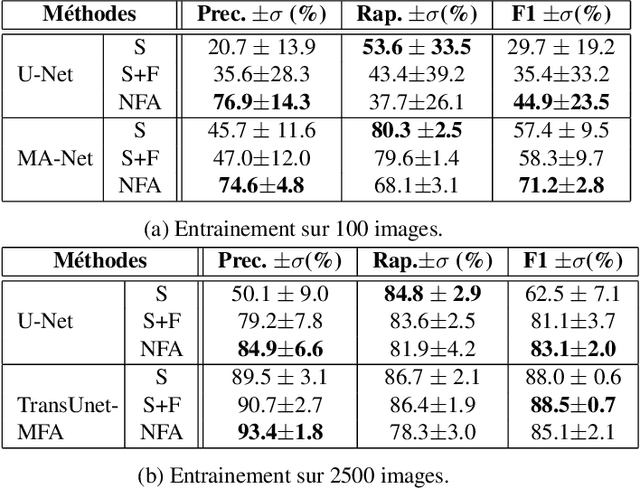
Abstract:Small target detection is an essential yet challenging task in defense applications, since differentiating low-contrast targets from natural textured and noisy environment remains difficult. To better take into account the contextual information, we propose to explore deep learning approaches based on attention mechanisms. Specifically, we propose a customized version of TransUnet including channel attention, which has shown a significant improvement in performance. Moreover, the lack of annotated data induces weak detection precision, leading to many false alarms. We thus explore a contrario methods in order to select meaningful potential targets detected by a weak deep learning training. -- La d\'etection de petites cibles est une probl\'ematique d\'elicate mais essentielle dans le domaine de la d\'efense, notamment lorsqu'il s'agit de diff\'erencier ces cibles d'un fond bruit\'e ou textur\'e, ou lorsqu'elles sont de faible contraste. Pour mieux prendre en compte les informations contextuelles, nous proposons d'explorer diff\'erentes approches de segmentation par apprentissage profond, dont certaines bas\'ees sur les m\'ecanismes d'attention. Nous proposons \'egalement d'inclure un module d'attention par canal au TransUnet, r\'eseau \`a l'\'etat de l'art, ce qui permet d'am\'eliorer significativement les performances. Par ailleurs, le manque de donn\'ees annot\'ees induit une perte en pr\'ecision lors des d\'etections, conduisant \`a de nombreuses fausses alarmes non pertinentes. Nous explorons donc des m\'ethodes a contrario afin de s\'electionner les cibles les plus significatives d\'etect\'ees par un r\'eseau entra\^in\'e avec peu de donn\'ees.
* 4 pages, in French
 Add to Chrome
Add to Chrome Add to Firefox
Add to Firefox Add to Edge
Add to Edge